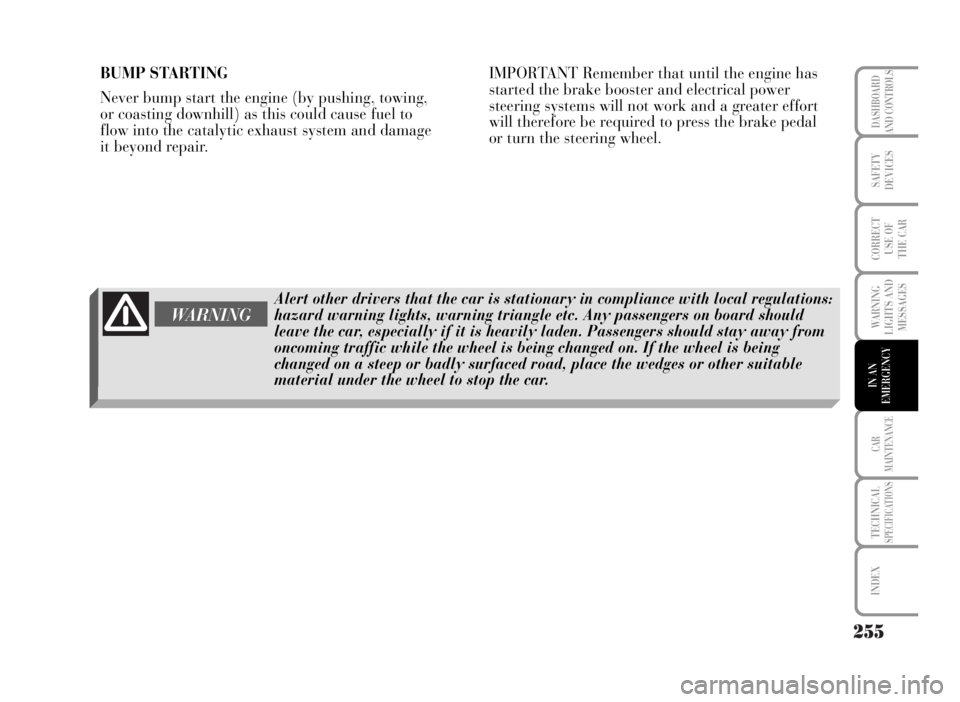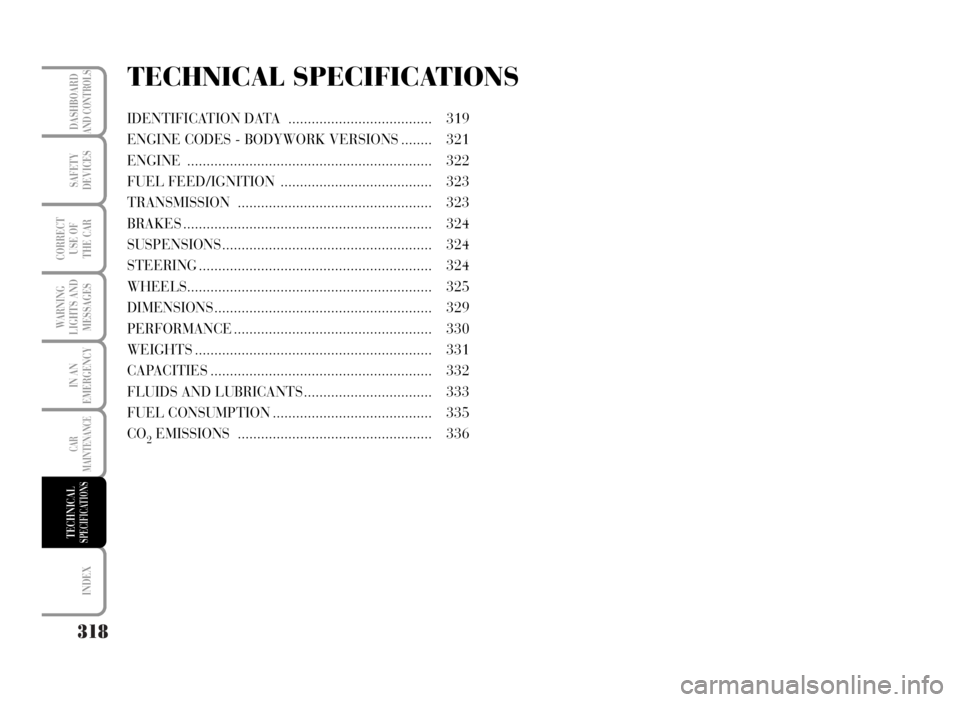steering Lancia Musa 2007 Owner handbook (in English)
[x] Cancel search | Manufacturer: LANCIA, Model Year: 2007, Model line: Musa, Model: Lancia Musa 2007Pages: 346, PDF Size: 5.15 MB
Page 218 of 346

217
IN AN
EMERGENCY
CAR
MAINTENANCE
TECHNICALSPECIFICATIONS
INDEX
DASHBOARD
AND CONTROLS
SAFETY
DEVICES
CORRECT
USE OF
THE CAR
WARNING
LIGHTS AND
MESSAGES
INCOMPLETE DOOR LOCKING
The warning light on the dial turns on (together with the message on
the display) when one or more doors, the boot or the bonnet are not
properly shut.
Symbols
¯/˙shown on the display indicate incomplete left/right door
closing.
´
(*) Or rear
red(*)
“DUALDRIVE” ELECTRIC POWER STEERING SYSTEM
The wording CITY is only displayed when the “dualdrive” electric
power steering is engaged.
Warning
light on
dial Message on
multifunction
display
Page 223 of 346

222
IN AN
EMERGENCY
CAR
MAINTENANCE
TECHNICALSPECIFICATIONS
INDEX
DASHBOARD
AND CONTROLS
SAFETY
DEVICES
CORRECT
USE OF
THE CAR
WARNING
LIGHTS AND
MESSAGES
Warning
light on
dialMessage on
multifunction
display
GLOW FLAT TYRE WARNING LIGHT (where provided)
The instrument panel warning light comes on (together with the
dedicated message on the display and the buzzer), when the pressure
of one of more tyres falls below the preset threshold. In this way the
T.P.M.S. system will warn the driver that there is/are tyre/s
dangerously flat (risk of punctured tyre/s).
IMPORTANT If a tyre is punctured, stop immediately to safeguard car
driveability. Avoid sharp braking and steering. Replace immediately
the punctured tyre with the space-saver spare wheel (where provided)
or repair the punctured tyre using the kit provided for the purpose
(see section “In an emergency”) and contact Lancia Dealership as
soon as possible.
l
red
continued
Page 238 of 346

237
IN AN
EMERGENCY
CAR
MAINTENANCE
TECHNICALSPECIFICATIONS
INDEX
DASHBOARD
AND CONTROLS
SAFETY
DEVICES
CORRECT
USE OF
THE CAR
WARNING
LIGHTS AND
MESSAGES
“DUALDRIVE” ELECTRIC POWER STEERING FAILURE
(where provided)
Turning the ignition key to MAR the warning light on the dial turns
on, but it should go off after few seconds.
If the warning light stays on (together with the message on the
display), you will not have steering assistance and the effort on the
steering wheel will be increased, steering is however possible. Contact
Lancia Dealership.
DIESEL FUEL FILTER SENSOR FAILURE
The warning light on the dial comes on (together with the message on
the display) when diesel fuel filter sensor failure is detected. Contact
Lancia Dealership as soon as possible to have the fault removed.
GLOW PLUG WARMING FAILURE (Multijet versions)
The warning light on the instrument panel flashes for about 30
seconds after starting the engine (together with the message on the
display) when there is a failure in the glow plug warming system.
Contact Lancia Dealership to have the fault eliminated.
g
red
amber
amber
è
m
Warning
light on
dial Message on
multifunction
display
Page 256 of 346

255
WARNING
LIGHTS AND
MESSAGES
CAR
MAINTENANCE
TECHNICALSPECIFICATIONS
INDEX
DASHBOARD
AND CONTROLS
SAFETY
DEVICES
CORRECT
USE OF
THE CAR
IN AN
EMERGENCY
BUMP STARTING
Never bump start the engine (by pushing, towing,
or coasting downhill) as this could cause fuel to
flow into the catalytic exhaust system and damage
it beyond repair.IMPORTANT Remember that until the engine has
started the brake booster and electrical power
steering systems will not work and a greater effort
will therefore be required to press the brake pedal
or turn the steering wheel.
WARNING
Alert other drivers that the car is stationary in compliance with local regulations:
hazard warning lights, warning triangle etc. Any passengers on board should
leave the car, especially if it is heavily laden. Passengers should stay away from
oncoming traffic while the wheel is being changed on. If the wheel is being
changed on a steep or badly surfaced road, place the wedges or other suitable
material under the wheel to stop the car.
Page 263 of 346

262
WARNING
LIGHTS AND
MESSAGES
CAR
MAINTENANCE
TECHNICALSPECIFICATIONS
INDEX
DASHBOARD
AND CONTROLS
SAFETY
DEVICES
CORRECT
USE OF
THE CAR
IN AN
EMERGENCY
WARNING
The jack should only be used to change a wheel on the car for which it was
designed. It should not be put to other uses or employed to raise other models of
cars. Under no circumstances should it be used when carrying out repairs under
the car. An incorrectly positioned jack may cause the car to fall.
Do not use the jack to lift loads exceeding that indicated on the label attached to
the jack itself.
Do not fit snow chains on a space-saver spare wheel.
If a front wheel (drive wheel) is punctured and you require snow chains to
proceed, take a standard wheel from the rear axle and fit the space-saver spare
wheel in its place.
Having fitted two standard wheels on the front drive axle you can use snow
chains, thus solving the emergency situation.
WARNING
When driving with a space-saver spare wheel fitted, the driving performance of
your car may change. Avoid accelerating or braking suddenly, steering abruptly
or fast cornering.
The lifespan of a space-saver spare wheel is approximately 3000 km, after which
it will need to be replaced with another spare wheel of the same type. Never fit a
standard tyre on the space-saver spare wheel rim.
Have the wheel replaced and refitted as soon as possible. Never use two or more
spare wheels at the same time. Do not lubricate the bolt threads before fitting
them back: they could come loose.
WARNING
Fasten the wheel cap correctly to prevent the wheel from coming free in motion.
Never tamper with the inflation valve.
Never place tools between the rim and tyre. Check the tyre and space-saver spare
wheel pressure regularly. The tyre inflation pressure is shown in the “Technical
specifications” chapter.
Page 285 of 346

284
WARNING
LIGHTS AND
MESSAGES
CAR
MAINTENANCE
TECHNICALSPECIFICATIONS
INDEX
DASHBOARD
AND CONTROLS
SAFETY
DEVICES
CORRECT
USE OF
THE CAR
IN AN
EMERGENCY
Fuse box in engine compartment
USERFUSE AMPERE
Dashboard control unit 1F1 70
Power steering control unitF2 70
Ignition switchF3 20
Dashboard control unit 2F4 50
ABS / ESP control unitF5 60
Radiator electric fan (low speed) (all versions)F6 30
Radiator electric fan (high speed) (all versions excluded 1.4 16V heated) F7 40
Climate control electric fanF8 30
Headlight washerF9 20
HornF10 15
Electronic injection secondary servicesF11 15
Right main beam headlightF14 10
Left main beam headlightF15 10
Electronic injection primary servicesF17 10
+30 Engine control unit / Radiator electric fan remote control switch (1.9 Multijet) (*) F18 7,5
CompressorF19 7,5
Heated diesel oil filter (Multijet)F20 30
Fuel pumpF21 15
Electronic injection primary services (1.4 16V)F22 15
Electronic injection primary services (Multijet)F22 20
Dual FuNction System gearbox oil pumpF23 15
Dual FuNction System gearbox fuse box power supply (+ key) F16 7,5
+15 Electric power steering (*)F24 7,5
Front fog lightsF30 15
(*) +30 = battery directive positive terminal (not under key)
+15 = positive terminal under key
Page 290 of 346

289
WARNING
LIGHTS AND
MESSAGES
CAR
MAINTENANCE
TECHNICALSPECIFICATIONS
INDEX
DASHBOARD
AND CONTROLS
SAFETY
DEVICES
CORRECT
USE OF
THE CAR
IN AN
EMERGENCY
WARNING
WARNING
Do not start the engine when towing the car.
WARNING
While the car is being towed with the
engine off, remember that the brake pedal
and steering will require more effort as
you no longer have the benefit of the brake
booster and the electrical power steering.
Do not use flexible cables to tow. Avoid
jerking. Whilst towing, ensure that the
coupling to the car does not damage the
surrounding components. When towing the
car, you must comply with the specific
traffic regulations regarding the tow hitch
and how to tow on the road. TOW RING HOOKING
Proceed as follows:
❒take the tow ring B from its support;
❒tighten the ring on the rear or front threaded pin.
Before starting to tow, turn the ignition
key to MAR and then to STOP. Do not
remove the key. If the key is removed, the
steering lock engages automatically which
prevents the wheels being turned.
L0D0204m
L0D0205m
Page 311 of 346

❒Avoid overloading the vehicle when travelling:
this may cause serious damage to the wheels and
tyres;
❒If a tyre is punctured, stop immediately and
change it to avoid damage to the tyre, the rim,
suspensions and steering system;
❒Tyres age even if they are not used much. Cracks
in the tread rubber are a sign of ageing. In any
case, if the tyres have been on the car for over 6
years, they should be checked by specialised
personnel, to see if they can still be used.
Also remember to check the spare wheel;
❒In the case of replacement, always fit new tyres,
avoiding those of dubious origin;
❒If a tyre is changed, also change the inflation
valve;
❒To allow even wear between the front and rear
tyres, it is advisable to change them over every
10-15 thousand kilometres, keeping them on the
same side of the car so as to not reverse the
direction of rotation.
310
WARNING
LIGHTS AND
MESSAGES
TECHNICALSPECIFICATIONS
INDEX
DASHBOARD
AND CONTROLS
SAFETY
DEVICES
CORRECT
USE OF
THE CAR
IN AN
EMERGENCY
CAR
MAINTENANCE
WARNINGIf the pressure is too low the tyre overheats and this can cause it serious damage.
WARNINGRemember that road holding depends also on the correct tyre inflating pressure.
WARNINGDo not cross switch the tyres, moving them from the right of the car to the left and
vice versa.
Never submit alloy rims to repainting treatments requiring to use temperatures
exceeding 150°C since the mechanical properties of the wheels could be impaired.
WARNING
Page 318 of 346

317
WARNING
LIGHTS AND
MESSAGES
TECHNICALSPECIFICATIONS
INDEX
DASHBOARD
AND CONTROLS
SAFETY
DEVICES
CORRECT
USE OF
THE CAR
IN AN
EMERGENCY
CAR
MAINTENANCE
INTERIORS
Periodically check that water is not trapped under
the mats (due to water dripping off shoes,
umbrellas, etc.) which could cause oxidisation of the
sheet metal.
CLEANING SEATS AND FABRIC AND VELVET
PA R T S
Use a soft brush or vacuum cleaner to remove dust.
Velvet is cleaned better if the brush is moistened.
Rub the seats with a sponge moistened with a
solution of water and neutral detergent.
INTERIOR PLASTIC PARTS
For routine cleaning, wipe with a cloth with water
and neutral non-abrasive detergent. Remove grease
or persistent stains with appropriate products
designed to preserve the appearance of components.
IMPORTANT Never use spirit or petroleum to clean
the instrument panel or other plastic parts.STEERING WHEEL/GEAR LEVER KNOB
WITH GENUINE LEATHER COVERING
These components shall only be cleaned with water
and neutral soap. Never use spirit or alcohol-based
products.
Before using special products for cleaning interiors,
read carefully label instructions and indications to
make sure they are free from spirit and/or alcohol-
based substances.
If when cleaning the windscreen with special glass
products, some drops fall on the leather covering of
the steering wheel/gear lever knob remove them
immediately and then clean with water and neutral
soap.
IMPORTANT Take the utmost care when engaging
the steering lock to prevent scratching the leather
covering.
Do not keep aerosol cans in the car: they might explode. Aerosol cans must never
be exposed to a temperature above 50°C. The temperature inside the car exposed
to the sun may go well beyond that figure.
WARNING
Page 319 of 346

318
WARNING
LIGHTS AND
MESSAGES
INDEX
DASHBOARDAND CONTROLS
SAFETY
DEVICES
CORRECT
USE OF
THE CAR
IN AN
EMERGENCY
CAR
MAINTENANCE
TECHNICALSPECIFICATIONS
TECHNICAL SPECIFICATIONS
IDENTIFICATION DATA ..................................... 319
ENGINE CODES - BODYWORK VERSIONS ........ 321
ENGINE ............................................................... 322
FUEL FEED/IGNITION ....................................... 323
TRANSMISSION .................................................. 323
BRAKES ................................................................ 324
SUSPENSIONS ...................................................... 324
STEERING ............................................................ 324
WHEELS............................................................... 325
DIMENSIONS ........................................................ 329
PERFORMANCE ................................................... 330
WEIGHTS ............................................................. 331
CAPACITIES ......................................................... 332
FLUIDS AND LUBRICANTS ................................. 333
FUEL CONSUMPTION ......................................... 335
CO
2EMISSIONS .................................................. 336